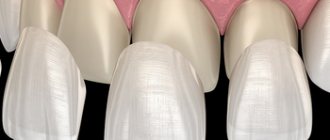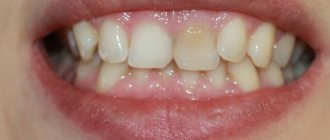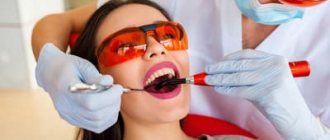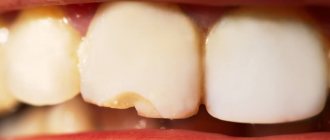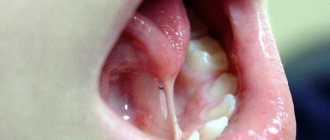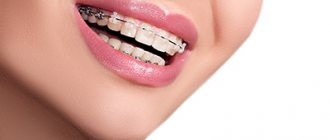To correct an abnormal bite, you can put braces on your teeth. Such orthodontic systems affect bone tissue, muscles and ligaments, and help slowly move teeth into the correct position. Many people are interested in the question: is it possible to put braces on one jaw? You will find the answer in this article.
In this article
- What are braces?
- Are braces placed on one jaw?
- Main indications for partial correction
- Orthodontic correction up to 12 years
- Braces for the lower jaw only for mild crowding
- Treatment for crowded upper anterior incisors
- Closing the gap between the front incisors
- Partial bracket system for preparation for prosthetics
- Absence of chewing teeth on the opposite jaw
- Should I install braces on one jaw or not?
What are braces?
A brace system is an orthodontic device that is installed on the teeth and helps them move in the desired direction. Structurally, this device consists of small plates (directly braces), which are glued to the dental crown at pre-calculated points, and a metal arch. This arc has shape memory and is an active element of the system. Fixed on the plates, it tries to regain its even position and thereby puts pressure on the teeth. As a result, their slow, gradual movement in the bone tissue occurs. Orthodontic treatment not only helps to correct the curvature of individual teeth in a row, it allows you to change the shape and position of the jaw, and restore facial symmetry.
It is preferable to begin orthodontic correction in childhood. But modern medical capabilities make it possible to carry it out even in adulthood and old age.
Most often, an orthodontic device is placed on two jaws at once. The dentist calculates in advance in which direction a particular tooth should move, how much it is necessary to expand the jaw or spread the dentition. Double-jaw treatment is comprehensive and allows you to solve global problems in occlusion correction. It usually takes from several months to several years.
Material for manufacturing orthodontic systems
The choice of material for orthodontic structures is quite wide:
- metal;
- plastic;
- ceramics;
- dental sapphire.
Metal ones are the cheapest. Metal braces look scary, but they are one of the best in terms of treatment effectiveness. The metal does not stain when worn, does not bend or break.
Patients try to choose inconspicuous structures made of plastic/ceramics/sapphire for the upper jaw. However, everything has its own characteristics. For example, plastic braces begin to turn yellow over time and may not withstand the load - they break. Such designs can be worn for no more than six months with a slight curvature of the row.
Ceramics are more resistant to stress compared to plastic. Ceramic braces can be almost invisible if the color of the material is matched to the tone of the enamel. Sapphire braces are made from a special crystal grown under certain conditions. Such hardware structures are not inferior in strength to metal ones and are not noticeable. The whole issue is the high price.
Are braces placed on one jaw?
Installing a brace system is one of the most common and effective methods for correcting an abnormal bite, improper closure of the teeth of the upper and lower jaw. Crooked teeth and abnormal jaw position not only spoil a person’s appearance, but also affect his health. Therefore, correcting the bite is important and necessary. But installing braces confuses many people.
Some are concerned about aesthetics, others are concerned about possible inconveniences when wearing the system, others simply want to save on orthodontic correction. And then the patient turns to the doctor with the following question: is it possible to install braces only on the upper jaw or only on the lower jaw.
As a rule, a person knows in advance which teeth he wants to change. And if they are located only on one jaw, then he expects that he will have a partial braces installed, only in the area of the curvature.
The doctor must make such a decision. It may seem to the patient that he has a problem only with the lower jaw, but the dentist sees during the examination that partial correction will not give an effective result. In this case, the orthodontist will insist on a complete correction. If you need a stable result of orthodontic treatment, we recommend listening to the professional opinion of an orthodontist.
When is the best time to get rid of braces?
For many decades, braces have remained the best orthodontic structures that can cope even with complex bite defects. But installing braces is not always acceptable. There are contraindications to this correction method, which relate not only to dental conditions, but also to other concomitant pathologies.
Placing braces on 2 jaws is contraindicated in the following cases:
- excessively narrow jaw;
- bone diseases;
- absence of several teeth in a row;
- endocrinological diseases;
- mental illnesses;
- infectious processes in the oral cavity and a number of systemic infections;
- immunodeficiency;
- any cancer.
The orthodontist does not begin bite treatment if the patient has dental diseases. If the pathologies are temporary and treatable, then the oral cavity must first be sanitized. Also, for preventive purposes, professional teeth cleaning is first performed to prevent the development of caries during the period of malocclusion treatment.
Main indications for partial correction
In some cases, it is indeed possible to place braces on one jaw, and this approach will be effective. As a rule, these are situations where the teeth are only crooked at the top or bottom, but the bite is not broken and there is no facial asymmetry. Partial correction may be recommended for the following indications:
- one or two teeth are positioned incorrectly;
- slight crowding of teeth (lack of space - up to 3 mm);
- a gap between the front incisors in the absence of pathological closure of premolars and molars;
- correction of the position of teeth before installing dentures;
- the need to avoid sagging of the upper teeth when their antagonists (opposite units) in the lower jaw are absent.
Diagnostics will show how effective braces will be only on the upper jaw or, conversely, on the lower jaw. It should include a visual examination, x-rays, assessment of the condition of bone tissue and dental roots.
Let's consider cases when it is justified to place braces separately on the upper jaw and separately on the lower jaw.
Excessive eruption of lateral teeth in the absence of antagonists in the opposite row
If one or two upper molars for any reason lack antagonists in the lower jaw, they will erupt until they reach contact. Therefore, before starting prosthetics in the lower row, it is necessary to return the excessively protruded upper teeth to the correct position in order to obtain a place that is currently missing for prosthetics.
In such situations, not only braces are used, but also microimplants, which in this case serve as temporary additional support. The treatment is carried out only on the upper jaw and requires high skill. You can insert a tooth no more than 2–3 mm, and for this you will need to accurately calculate the magnitudes and directions of all forces acting on it.
Orthodontic correction up to 12 years
Braces are primarily used for children starting in their teens. This is due to the fact that by the age of 11-12 years the formation of the jaws is completed, and the primary bite is replaced by a permanent one. But often, an orthodontist discovers bite problems in a child at an earlier age. Installing partial braces helps solve some of them, as well as prepare teeth for further correction in adolescence.
The doctor can place an orthodontic device on one jaw or individual teeth in order to:
- create space for the eruption of permanent teeth;
- expand one of the jaws;
- close the gap between the front incisors (the so-called diastema);
- correct the incorrect position of one or more teeth that are bothering the child;
- preserve the space left after early removal of baby teeth, which neighboring ones are trying to occupy.
Thus, braces can be placed on one jaw at the age of 9-10 years to solve a specific orthodontic problem. In this case, in adolescence, further, already double-jaw, treatment will be required.
Braces or mouthguards - which is better?
What to do if only one tooth is crooked? This occurs in the practice of orthodontists. If your bite is normal, your doctor may suggest removable clear aligners. Such structures are placed on a molar or incisor that does not have enough space on the jaw. Typically, aligners are worn for only a few months. However, mouthguards are not used in all cases: if the tooth has turned to the side, treatment with braces is prescribed. Typically, canines and front incisors are corrected with mouthguards.
Placing transparent aligners is much cheaper. But is the question of price always justified? Let's look at the advantages of braces over removable aligners:
- The bracket system puts constant pressure on the tooth, which speeds up the process of straightening the curvature.
- With the help of removable structures (alignments), it is problematic to achieve ideal evenness of the dentition.
- Braces are more convenient to use than mouthguards.
- Braces do not affect pronunciation: the patient does not have a lisp.
How long does it take to correct the bite and teeth using braces? This usually takes a period of ten months. For children, the period of wearing orthodontic structures doubles - this is due to the eruption of all permanent molars.
Braces for the lower jaw only for mild crowding
Crowding is the position of teeth when they are too close to each other. As a result, rotation, curvature, and “layering” of each other occur. If slight crowding is observed only on the lower front incisors, while the upper front incisors are positioned evenly and the lateral ones close correctly, in this case, braces are sometimes placed only on the lower jaw. An important condition for this method is that there must be enough space to move horizontally so that the teeth can take the correct position. This treatment method is chosen in cases where the lack of space for alignment is less than 3 mm. With this method, separation of the front incisors is almost always performed - that is, minor grinding of the contact surfaces, which allows you to free 0.25 mm from each surface and in total create those missing 1-3 mm for alignment in the dentition.
Advantages and disadvantages of installing braces on both jaws
The invention of braces completely changed all previously existing views on aesthetic dentistry. Patients were able to effectively and quickly correct pathologies of the position of teeth and bite, without resorting to highly traumatic surgical interventions.
Meanwhile, orthodontic treatment with braces also has a number of disadvantages. These include:
- the presence of a wide range of contraindications to the procedure (cardiological, oncological, endocrine, allergic, mental diseases, periodontal disease, development of inflammatory processes, alcoholism, etc.);
- long duration of the adaptation period (after installation of an orthodontic device, the patient experiences pain and discomfort for a long time, and encounters problems with diction);
- deterioration in the aesthetics of a smile (except for those cases when lingual invisible braces are used to correct the position of teeth and bite);
- the emergence of difficulties during hygienic procedures;
- the appearance of minor injuries to the oral mucosa;
- the need to follow a special diet (avoiding too hard, viscous foods, etc.);
- relatively high cost of treatment involving the use of braces.
Meanwhile, all of the listed shortcomings quickly lose significance against the background of the achieved results. A beautiful facial contour, a healthy and even smile become a truly worthy reward for all the difficulties that the patient has to cope with during treatment.
Treatment for crowded upper anterior incisors
Braces on the upper jaw only can be placed if crowding is observed on the upper front incisors. The conditions are the same - the space deficit should be no more than 2-3 mm. In addition, treatment should not require expansion of the dentition. In this case, for orthodontic correction it is not necessary to involve the lower dentition.
If you provide space for uneven teeth by expanding the upper row, this will disrupt the closure. As a result, the teeth will “seek contact” with each other, the upper row will become narrow again, and in the long term the goal of orthodontic treatment will not be achieved. Therefore, if it is necessary to expand the upper row of teeth in order to correct crowding, a partial braces system cannot be used; a two-jaw apparatus will have to be installed. Braces can only be placed on the upper jaw if space for teeth is freed up using the separation method (their width is reduced by grinding the contact surfaces).
Kinds
The following types of materials are used to make braces:
- metal structures, characterized by an affordable price for braces for both jaws, durability, easy installation and adjustment;
- ceramic, inconspicuous, durable, preserving the aesthetics of the frontal area;
- silicone transparent, characterized by high aesthetics, but indicated for the correction of minor pathologies, slight curvature;
- sapphire systems based on a single crystal, which have high aesthetics and are almost invisible on the enamel surface;
- combined, for example, transparent ceramic or sapphire braces are used for the top row, and metal-based for the bottom row.
Closing the gap between the front incisors
Braces can be placed on the lower jaw if there is a large gap (diastema) between the lower front incisors. In this case, several conditions must be met:
- the lateral teeth close together normally;
- there is an opportunity for a “joint to joint” closure of the front teeth of the upper and lower rows.
If these conditions are not met, it may be necessary to artificially increase the size of those teeth between which there is a gap. This is done using filling material. If the patient is not ready to fill healthy teeth in order to increase their size, then single-jaw treatment of diastema will not suit him, since the doctor will not be able to guarantee the stability of the result.
Types and design of braces
Is there a difference between upper and lower jaw braces? In practice, the installation of braces on the top row has become more widespread. This is explained by the desire of patients to achieve a beautiful smile. The lower teeth are not always visible when talking and smiling, so few people care about the evenness of the lower row.
For the upper row, there are many types of orthodontic structures made of different materials. There are expensive aesthetic braces, and there are cheaper ones. If the design features of the braces are chosen by the orthodontist according to the patient’s jaw type, then the choice of material for making the braces depends on the financial and aesthetic needs of the person.
Depending on the design features, braces are:
- ligatures;
- self-regulating;
- lingual;
- removable mouthguards.
Ligature structures cause discomfort to the patient due to changes in the chewing load. It is not possible to correct the situation; the patient is forced to get used to the pressure. Self-adjusting braces can be adjusted independently depending on how you feel. However, they also cost more than ligature ones.
The most expensive are lingual braces, which are attached to the inside of the jaw. These structures are completely invisible and do not cause aesthetic discomfort to the patient. The advantage of the lingual system is ideal closure - they do not affect the bite. The high cost of these devices is explained by the use of expensive metal alloys in the composition (sometimes with gold plating). The disadvantage is a temporary impairment of diction when wearing the device.
Removable aligners are used to correct one or two crooked teeth. The advantage of mouthguards is their low price. Disadvantage - they do not provide ideal evenness to the entire dentition due to pinpoint impact, and do not affect the correction of the bite.
Partial bracket system for preparation for prosthetics
Sometimes braces are placed on only one jaw in preparation for prosthetics or in order to close empty spaces from extracted teeth. In the first case, braces help change the angle of the teeth to make room for an implant or bridge. In the second case, the brace system is used to move the posterior chewing tooth to the place of the previously removed one, thereby closing the empty gap and avoiding prosthetics. It is important to note that such treatment is usually complex and lengthy (tooth movement can take up to four years).
The orthodontist decides how appropriate it is to install a partial brace system for such indications in each specific case.
Braces for the lower jaw - which ones to choose?
The lower teeth are not as visible as the upper teeth - when talking or smiling, they are practically hidden by the upper jaw and lower lip, so any braces can be installed.
- Metal braces are the most reliable and affordable braces; they provide quick results and fairly gentle pressure due to reduced friction between the arch and the grooves.
- Ceramic - durable and elegant designs that do not stand out against the background of teeth.
- Sapphire devices are the most aesthetically pleasing devices; they do not stain during wear, but the price of braces for the lower teeth made of artificial sapphire is quite high.
- Lingual - are installed on the inner surface of the teeth, so they are completely invisible even from a close distance, but there are some difficulties with getting used to (at first, diction is impaired, the tongue touches the locks and is scratched), the price is approximately equal to sapphire structures.
Should I install braces on one jaw or not?
If the patient is concerned about the question of whether braces are placed on the lower jaw, then the answer will be positive. An orthodontic device can be installed not only on the lower or upper jaw, but also on individual teeth or areas of the dentition. But the main question is whether such treatment would be advisable. As a rule, installing a brace system on one jaw solves exclusively local dental problems. This process is more difficult to control and provides fewer treatment options. If contraindications are not provided, even a successful result will be short-lived, and the teeth will return to their previous position.
Thus, a dentist planning single-jaw orthodontic treatment must carefully assess the risks, take into account the many factors that will influence tooth movement and predict in advance the effectiveness and stability of the result.
If the doctor sees that solving the problem with a partial braces system will be problematic, he will recommend double-jaw treatment to the patient. Its advantages are that teeth can move in different planes without negative effects such as disruption of contacts between the upper and lower ones. Plus, such treatment is easier to predict and control, and it gives a more sustainable result.
Cost of braces
If there are indications for installing the system on both jaws and there is a lack of financial resources, you can choose a model at a lower cost, or take advantage of the clinic’s offer “Braces in installments/credit.” If the orthodontist recommends installing the structure only on the upper jaw, then you can safely save money without fear of consequences.
Correct bite means a beautiful smile, healthy teeth and the absence of a number of problems that arise from bite defects. A-Medic Clinic offers to correct the consequences of damage or congenital pathology by installing braces. You can find out how much braces for the upper jaw cost on the dentist’s website, in the center itself, or from the clinic’s consultants.
The A-Medic clinic often holds promotions offering treatment with braces at a discount. You can find out about the best offers in the “Promotions” section. We also recommend that you learn more about the possibility of receiving the service in installments in the section “Braces in installments.”
Frequently asked questions about braces
— Does it hurt to get braces?
— It doesn’t hurt to install braces; the whole procedure takes place within an hour with the installation of braces on one jaw. The most unpleasant sensation in the procedure is that you cannot close your mouth. Painful sensations begin after we completely install the arch. The teeth are corrected under the action of the tension of the arch; the tooth begins to be pulled through the brace to the position to which the arch forces it to move. The arcs have the correct shape - a semicircle, parabola, or half-ellipse.
— Why do you need to correct your bite?
— The bite must be corrected in childhood in order for the child to eat properly, because the oral cavity is the first point in food processing. If a person “swallows” food, then problems with the gastrointestinal tract begin because of this. Also, incorrect position of the jaws can have a bad effect on the condition of the temporomandibular joint; it can hurt and cause complications in the form of headaches, difficulty opening the mouth, clicking and crunching in the joint. Also, an incorrect bite affects posture; the position of the head, due to the way our lower jaw is located in relation to the upper jaw, can change. This is a tilt of the head forward or backward. Plus, no one has canceled the aesthetic function - a beautiful smile is attractive and this is the first thing people pay attention to
—At what age is it better to correct teeth?
- Of course, it is better to start correcting teeth in childhood; from 6 to 11 years old we use orthodontic removable appliances - these are either individual plates or silicone appliances. It is possible to use a brace system from 8 to 11 years of age if there are indications for a partial brace system. The use of a full braces system begins at the age of 13-14, when the complete replacement of baby teeth with permanent ones has occurred and the teenager’s bite has already formed.
—How long does the treatment last?
— Treatment lasts for a year using removable devices, and for one and a half to two years when using braces.
—Do braces damage tooth enamel?
— Braces do not damage tooth enamel; poor oral hygiene does. Patients do not clean the soft plaque that accumulates around braces well enough, because of this, bacterial plaque begins to destroy the surface layer of enamel. Chalky spots and inflammatory reactions on the gums form - this is bleeding and swelling of the gums.
—I have a problem with braces, is there a more aesthetic option for straightening my teeth?
— Yes, in Estetik dentistry, the position of teeth can be corrected without using a brace system, but there are limited cases for this - a slight grouping, or minor changes in the bite. Such abnormalities can be corrected using progressive tooth alignment aligners. There is also an option for an aesthetic bracket system - these are sapphire or ceramic systems, and a white arch is selected to match the color of the teeth.
—How long does it take for a person to get used to braces?
— Each patient is individual, on average, addiction occurs in 3-4 days, for those who are especially sensitive, up to a week. Teeth begin to move and begin to wear out if a person eats hard food. Therefore, a gentle diet is recommended for the first 3-4 days. Subsequently, braces do not cause any discomfort.
—Do I need to wear anything else after wearing braces?
— After the bracket system is removed, a retention device is installed. This is a non-removable retainer strip on the inner surface of the six central teeth, it is permanently fixed to a special material, and a special tray is issued to the upper jaw, which maintains the result of the position of the teeth. Retention devices are worn from 5 to 10 years.
—Is it possible to have braces installed during pregnancy? How does pregnancy affect already installed braces? Will it be necessary to suspend treatment in such cases?
— During pregnancy, braces can be installed. This is not a contraindication; teeth will be more mobile due to changes in hormonal levels in women. Treatment is suspended in cases where there is a possibility of delivery through cesarean section and there is a need for general anesthesia. In these cases, you need to consult your obstetrician-gynecologist, and he will tell you about all the recommendations.
—What do you need to see an orthodontist? Should professional hygiene be carried out, and if so, how many days in advance?
— If the patient is an adult, a 3d-CBCT (cone-beam computed tomography) of the upper and lower jaw and TRG (teleradiography) lateral projection are required. If it’s a child, then a panoramic shot is enough. At the time of consultation, the teeth must be cured, professional hygiene must be carried out two weeks before installing the braces system.
Sign up now
By submitting data from the form, you consent to the processing of personal data in accordance with the personal data processing policy
